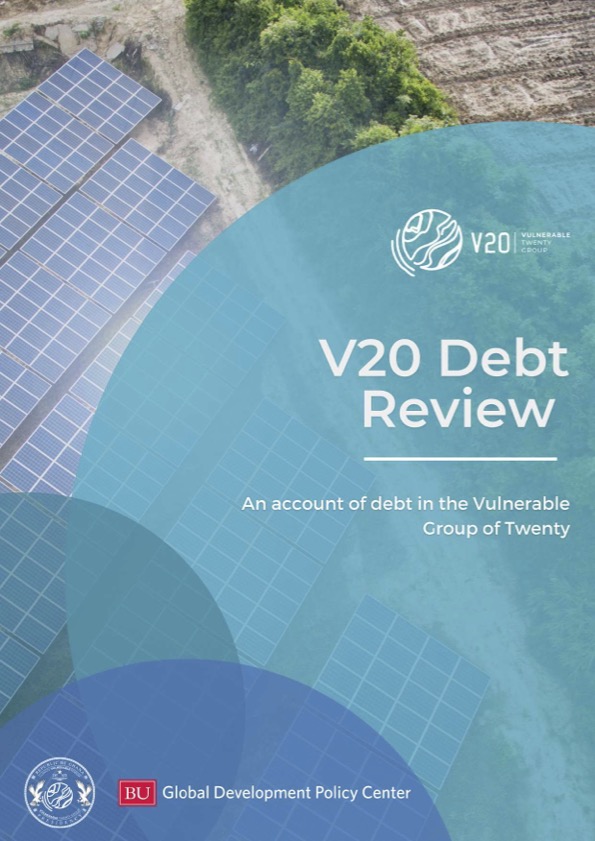Emerging market and developing countries (EMDs) are struggling to cope with the persistent presence of the COVID-19 pandemic, the global ramifications of Russia’s war in Ukraine, a growing climate crisis and rapid interest rate increases in advanced economies.
The Vulnerable Twenty (V20) Group of Finance Ministers includes 55 climate vulnerable economies. This group is at the epicenter of these crises which threaten their ability to mobilize the necessary resources to build resilient and low-carbon economies moving forward. Even prior to the pandemic, debt levels were climbing across developing countries. In the V20, total debt climbed from $464 billion in 2015 to $570 billion in 2018 and $686 billion in 2020. This comes at the same time that investments in sustainable infrastructure investments need to be scaled up by $3.2 trillion per year to meet the UN 2030 Sustainable Development Goals and to limit global warming to 2°C (Bhattacharya et al. 2019).
In addition to other necessary global measures such as increasing the availability of global liquidity and insurance, the V20 released a statement calling for a global debt restructuring scheme (V20 2021) that would link debt relief to climate and development goals prior to the 2021 United Nations Climate Conference in Glasgow (COP26).
To provide background on the scale, composition and distribution of V20 debt, this policy brief provides a detailed look at the V20’s debt profile. It identifies the creditors, their relative salience and trends in debt servicing costs. Understanding these components of the V20’s debt profile is crucial to devising a global debt workout and coordinated policy response that places climate change and vulnerable nations at the center. transporting
Key takeaways
• In terms of external debt stock, the V20 as a group has a total of $686.3 billion in external public debt. This amounts to 27 percent of the group’s gross domestic product (GDP). The V20’s total debt stock is one-fifth of all developing country debt (public and publicly guaranteed).
• Private creditors comprise the largest share of external debt stocks in V20 countries at 36 percent, followed by the World Bank at 20 percent and multilateral development banks not including the World Bank at 20 percent. In terms of bilateral credit, Paris Club nations hold close to 16 percent of V20 debt stocks and China holds 7 percent of the total.
• In terms of external debt service payments, between 2022-2028, V20 countries will be responsible for almost $435.8 billion in payments to various creditors, with 2024 a particularly acute year at $68.9 billion. Again, private creditors top the payments list (34.6 percent), followed by multilateral institutions (16 percent) and the World Bank (12 percent). China is fifth with a share of 10 percent.
• Countries with the highest outstanding commitments are Colombia ($51 billion), Vietnam ($32.6 billion), Sri Lanka ($31 billion), Bangladesh ($30 billion) and the Philippines ($29.7 billion).
• Lebanon, Bhutan, Maldives and Mongolia have the highest debt-to-GDP ratios. Their debt compositions, however, are different. While private creditors hold most of Lebanon and Mongolia’s debt, China is the largest creditor of the Maldives. For Bhutan, bilateral debt forms the largest share, and the precise amount owed to China is uncertain.
• For 13 V20 countries classified as in debt distress or at high risk, the debt stock composition shows that the private sector owns 39 percent of the total debt stock, the World Bank holds 24 percent, China holds 16 percent and bilateral creditors without China also own 16 percent.
• Private bondholders are expected to receive the largest share of payments between 2022-2027, but from 2028 onward, multilateral development banks (MDBs) overtake private bondholders. Of the $18 billion that the V20 will owe to the MDBs, the World Bank is expected to receive $8 billion, with other MDBs receiving $10 billion.
As is the case with the broader group of EMDs, V20 debt portfolios consist of a much more diverse set of creditors than in previous eras, which makes restructuring debt more challenging. Nevertheless, given the diverse debt portfolio of V20 countries, comprehensive debt restructuring across all creditor classes is urgently necessary, rather than case-by-case bilateral negotiations with specific creditor classes.

